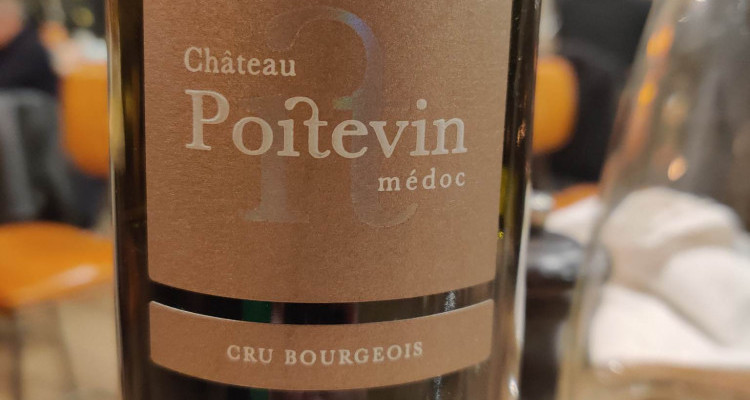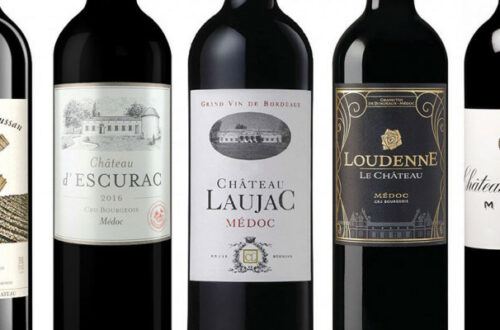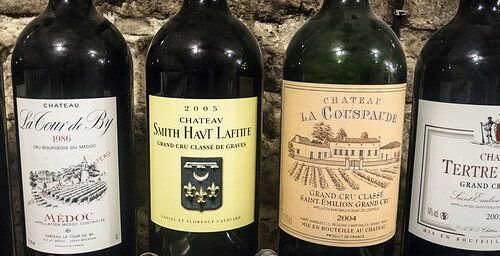
What kind of wine is a Médoc?
Médoc is a wine region AND an appellation (but we’ll come back to that) in the Bordeaux wine region.
First, Médoc comes from “med” and “oc”. “Med” means in the middle and “Oc” is short for ocean or water in a larger sense. This region is located between the Atlantic ocean and the Gironde river, hence the name “Médoc”.
Médoc is region that is quite recent in Bordeaux’s history. Indeed, it didn’t exist during the rise of Bordeaux in the Middle Ages. We had to wait until the 17th century for the Dutch to come and drain the whole area. Médoc was then born. (You can get the full story about the Dutch influence in this post)
Concerning the appellation, Médoc only produces red wine. The white wines produced in this area fall under the generic appellation : Bordeaux
Médoc is a wine region AND an appellation? What’s the difference?
So like I wrote in the introduction, Médoc is a wine region and an appellation but it doesn’t cover the same areas!
Who said French wine regions and appellations were simple?
Indeed, the Médoc area (or wine region, so I mean geographically) is divided into three areas : Les Landes, Bas Médoc and Haut-Médoc (now this one you may recognize as it is home to the most prestigious Châteaux).
The Landes is at the top of the peninsula and there are no vines actually there. It’s mostly covered by pines, which protects the vines from the Bas and Haut Médoc from the cold winds from the Atlantic ocean.
Bas Médoc lies at the south of Les Landes and used to be known as “La Petite Hollande” (Little Holland) due to the Dutch influence. We now call it Médoc when we’re talking about the AOC, hence the confusion.
Haut-Médoc lies at the south of Bas Médoc and is home to the most prestigious appellations such as Saint-Estèphe, Pauillac, Saint-Julien and Margaux. There is more fine wine per acre produced in Haut-Médoc than anywhere in the world.
So all in all, Médoc is a large geographical area, which contains Les Landes, Bas Médoc and Haut-Médoc AND an AOC, much smaller geographical area but is still one of the largest AOC.
Haut-Médoc is an AOC which belongs to the Médoc area. It’s the most prestigious AOC in the Médoc
What kind of wine is a Médoc? It’s all about the terroir
As you may have read in other posts, Bordeaux produces mainly blends. Indeed, Bordeaux is subject to the vintage effect so it would be too risky to count on ONE grape variety.
Médoc wines are considered best in the warmer vintages (where Cabernet Sauvignon ripens fully), such as 2002, 2003, 2005, 2006, 2008, 2009, 2010, 2012, 2014, 2015, 2016, 2018, 2019, 2020, 2021.
There is a reason why wines over the world are made as Bordeaux blends : Bordeaux’s blends have, by the way, influenced greatly the New World.
Bordeaux wines are usually a blend of Cabernet Sauvignon, Merlot, Cabernet Franc, Petit Verdot and a splash of Carmenère.
Concerning the Médoc, men (ie the Dutch) are at the origin of the nature of the soils. After they drained the whole place, they put a lot of gravel, which is a mixture of pebbles, sands and clays.
The pebbles are brought by the Garonne and the Dordogne rivers. These soil absorb and transmit heat, which is ideal for late-ripening grape varieties. And especially these soils are ideal for Cabernet Sauvignon! Thus, wines from the Médoc will be Cabernet Sauvignon-dominated blends.
However, the Dutch didn’t put only gravel but also a lot of limestone clay, which, with its draining properties, is ideal for Merlot. This explains why there are nearly half of the vines that are Merlot plantings.
The blends from Médoc are where the percentage of Merlot is the highest in the Cabernet Sauvignon-dominated blends.
What does a Médoc taste like?
The geographical Médoc contains two main appellations : Médoc and Haut-Médoc, with its prestigious sub-appellations.
AOC Médoc wines will have medium acidity and can be drunk young and will not gain much with bottle aging.
However, Haut-Médoc wines will also have medium acidity with high tannins (due to the Cabernet Sauvignon), high alcohol and complexity. These wines are made for aging. There is also a lot of terroir diversity in the sub-appellation which makes this region quite complex (but in a good way!)
Young wines will present aromas of cassis, blackberry, black cherry, liquorice, vanilla, coffee bean, spices… When aging, these aromas will become tobacco leaf, truffle, cigar, leather, spices, wet soil…
Haut-Médoc is the prestigious appellation in the Médoc are. However, these often come with high (and even cosmic) prices. SO for those like me, I would recommend watching out for the lesser known appellations Listrac and Moulis. They often use more Merlot in their blends and tend to avoid new oak. These are a high value appellations and excellent for value for money.
A Médoc wine can be a Grand Cru Classé … or not : what makes it so?
If you’ve been following me for a while, you’ll know all about the 1855 classification. But if not, let me refresh your memory.
In 1855, Paris hosted the third UNIVERSAL Exhibition. For this occasion, Napoleon III asked his ministers to contact the Chambers of Commerce and Industry of the candidate REGIONS for the exhibition to encourage them to present their best products there by classifying them.
The President of the Chamber of Commerce and Industry, through wine brokers, in Bordeaux decided to respond to this request by establishing a classification of Bordeaux wines. But, wait! This only applies to the LEFT Bank of Bordeaux.

The red wines all come from Médoc, except Château Haut-Brion who belongs to the Pessac Léognan appellation.
The white wines come from Sauternes or Barsac.
The criteria for this classification was the following :
- the vine root depth and the ages of the vines. This influenced the length of aromas and the body of the wine
- the vineyard elevation and the degree of natural light the grapes get
- the terroir
- the quoted value on the market.
Originally, the list included 58 châteaux. Over time, this list has evolved and now includes 61 châteaux : 5 Premier Crus (First Growth), 14 Second Crus (Second Growth), 14 Troisième Crus (Third Growth), 10 Quatrième Crus (Fourth Growth) and 18 Cinquièmes Crus (Fifth Growth)
This list was revised only once in 1973, when Château Mouton Rothschild was promoted from Second Growth to First Growth.
Concerning the white wines, 27 sweet wines were classified from Sauternes and Barsac. Château d’Yquem is the only Premier Cru Supérieur, 11 Châteaux constitute the Premier Cru and 15 the Second Cru.
Over the years, the number, size and owners of classified châteaux have changed a lot, as has the quality of their wines. The relevance of the 1855 ranking to current quality levels is the subject of ongoing debate.
All in all : what kind of wine is a Médoc wine?
All in all, if we’re talking about the geographical area, Médoc wines are Cabernet Sauvignon-dominated blends. These are wines that are elegant with fine tannins, firm in their youth.
Young wines will present aromas of cassis, blackberry, black cherry, liquorice, vanilla, coffee bean, spices… When aging, these aromas will become tobacco leaf, truffle, cigar, leather, spices, wet soil…
But if you really want to know all about Médoc wines, I suggest you read my post about spending time in Bordeaux and the wine tours I recommend : for only 80€, you get to taste several wines, one of which is a Margaux wine (and transport is included). Go check it out!







2 Comments
Kevin
Thank you so much for writing this post on what kind of wine is a Médoc! I thoroughly enjoyed your article and learned a ton. It is quite interesting hearing about how soil quality affects the grapes and the wine that gets produced. I heard that every year, the wine produced can be very different due to growth conditions, but I’ve always wondered, what factors do judges use to rate one wine as better than the other?
Mademoiselle
Hello Kevin and thank you for stopping by. Usually, we judge a wine by its complexity, it’s acidity, tannins and it’s length (the longer, the better).
i hope this answers your question